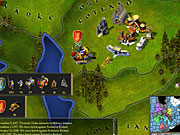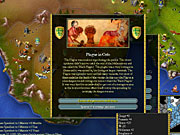Paradox Entertainment made a name for itself with Europa Universalis and Europa Universalis II by taking the premise of conquer-the-world board games like Risk to the logical extreme, filling its real-time strategy games with tremendous historical detail and complexity. But while Europa Universalis II offered a staggering array of options in letting you assume control any 15th-century nation in the world and try to become a dominant power by 1815, the latest game in the series takes place on a radically reduced scale. Crown of the North is a vastly simplified game, and while some of the changes are for the better, as a stand-alone game, it doesn't offer enough challenge or variety.

Crown of the North is set in the years 1275 to 1340, in a time when Scandinavia was divided by a number of royal factions vying for power. The game's single scenario takes place on a map that shows Norway, Sweden, Finland, and Denmark broken into many small provinces, plus German and Russian territories along the rim of the Baltic. At the start of the game, the six main playable factions control a single territory, and most of the map consists of neutral provinces just waiting to be conquered by you or the five computer-controlled players. Of course, remote provinces far to the north start out much weaker than the rich lands of historically established powers such as the Hanseatic League, the Order of the Templar, and the Russian territory of Novogorod, near St. Petersburg. These three large powers don't try to satisfy the game's victory conditions, but they're granted such immense armies that you won't want to mess with them.
The main map may be smaller in scale, but there's a lot of visual information packed into this single screen. Each territory has animated icons for farms and other buildings that provide a general sense of how well developed it is. Upgrading a building and fielding armies is as simple as clicking on the buildings. The building screens are also where you issue edicts, which are one of two ways to influence the happiness of the four social groups in the kingdom: nobles, clergy, townspeople, and peasants. Just check the icons at the top of the screen to see how you're faring with them.
Random and timed historical events also pop up, presenting multiple-choice political issues that will influence these groups and can also award or take away money and victory points. The events help provide some Scandinavian flavor, as some are mildly entertaining (challenging you to deal with troll or sea serpent sightings), while others provide historical background on the transition away from Viking traditions. In any case, the point is to shift a few numerical factors in your favor. Making the social groups happy grants tax bonuses, but upsetting one or another can encourage them to rebel. As you might expect, feudal nobles and peasants have sharply conflicting interests, so making one happy is likely to upset another. Fortunately, their concerns aren't too hard to balance if you build a decent economy and have some extra money lying around. Plenty of the events present the opportunity to buy loyalty.
Improving territories is the key to being able to field larger armies. There are seven or eight infrastructure buildings per territory (the castle, church, farm, market, city, defensive walls, and muster field, plus a harbor for coastal provinces) that determine how quickly the game's resources are collected, what kinds of military units can be produced, and how quickly those units are produced. The upgrading costs silver, and it's a fairly slow process, since only one building can be built or upgraded in a territory at any one time. Still, since the six factions are placed quite far apart at the start of a game, there's plenty of time to grab up some neutral lands before you have to worry about any real competition.

But as it turns out, the real competition never does show up. The economic model is such that any single territory will be too poor to build real armies, and since the independent neutral territories don't dare invade their neighbors, it's up to the five main computer-controlled factions to do something. But even at the higher settings for difficulty and AI aggressiveness, the computer players aren't at all smart about grabbing up land. They often seem content with a relatively small number of territories and don't use navies well to ferry armies around the Baltic to attack poorly defended rear-guard provinces. To make matters worse, the diplomacy system has been drastically simplified. Not only are there very few relevant powers to deal with, but there are few options other than to declare war, offer peace, or offer gifts in the hope of establishing an alliance. And it's just fine if one of the major powers does happen to declare war on you at an inopportune moment, because it doesn't cost anything to repeatedly click on the "peace offer" button, and even your worst enemy is likely to accept after a few tries.
The smaller scale and the simplified interface and mechanics make Crown of the North the easiest introduction to the world of Europa Universalis, but the lack of dynamic and challenging computer opponents drastically limits its depth and long-term appeal. And even if the interface is much simplified, it's still bound to be daunting for beginners. There isn't a tutorial specific to Crown of the North or any visual reminder of the necessary keyboard commands hidden at the back of the manual. For those who finish Crown of the North, Europa Universalis II is also included on the disc as a consolation prize. However, anyone just learning to play a game as challenging as Europa Universalis II might want to have the manual on hand, and somehow the PDF manual included here is missing every other page. And experienced Europa Universalis II players aren't likely to need the three user-created scenarios that are on the disc, since there are plenty of free scenarios on the Internet. As promising as some elements of Crown of the North are, it's too flawed to recommend.